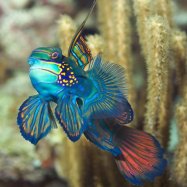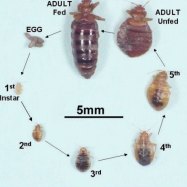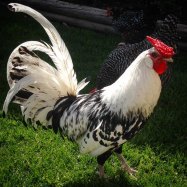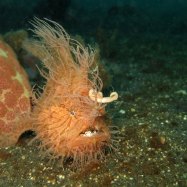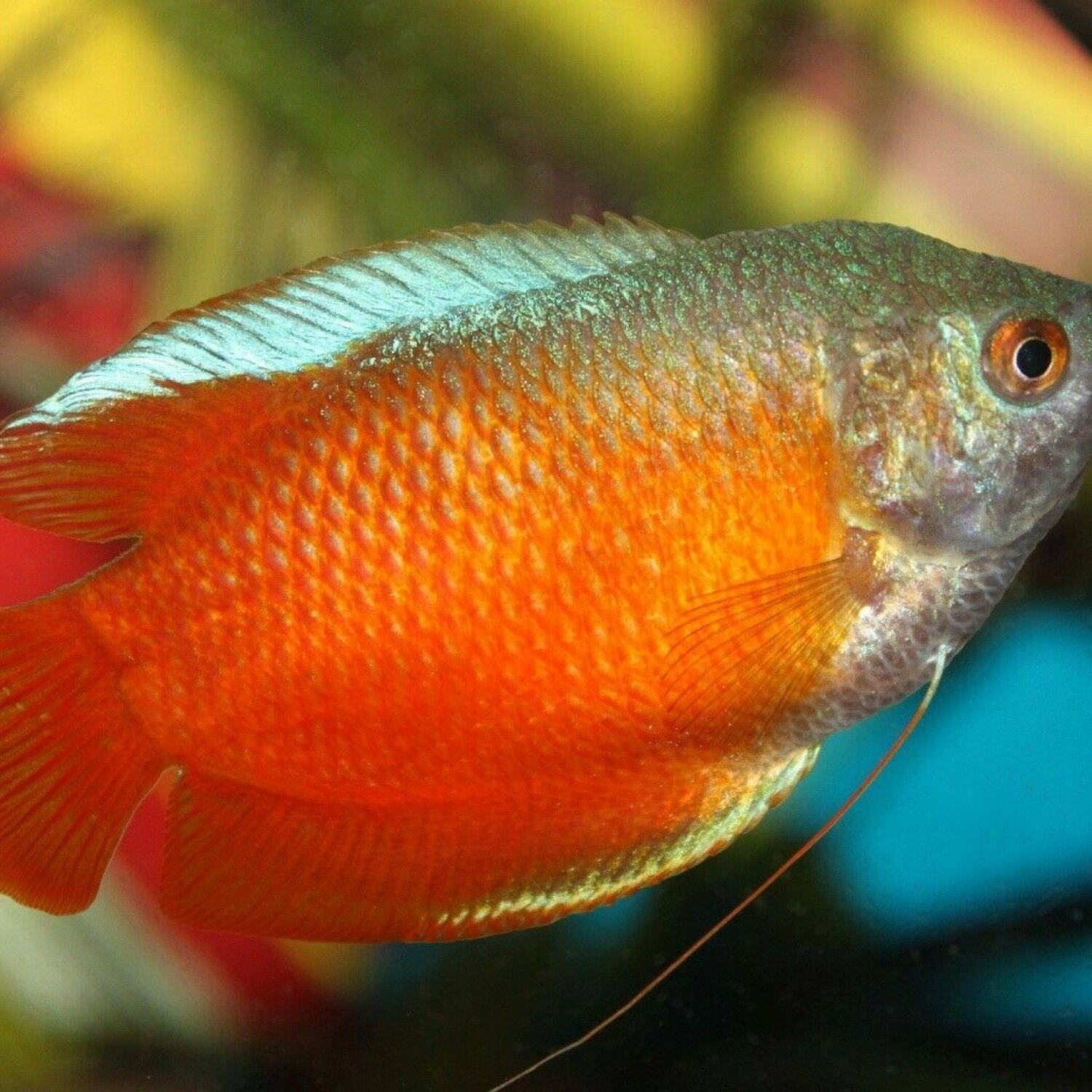
Dwarf Gourami
Up to 6 centimeters (2.4 inches)
The Dwarf Gourami, part of the Osphronemidae family, is a popular freshwater fish known for its vibrant colors and peaceful nature. With a maximum length of 6 cm (2.4 inches), it is a perfect addition to any aquarium. Found in rivers, ponds, and lakes, its slender and elongated body shape allows for swift movement in water. Consider adding this stunning fish to your aquatic collection! 🐟 #DwarfGourami #freshwaterfish #aquariumlife
Animal Details Summary:
Common Name: Dwarf Gourami
Kingdom: Animalia
Habitat: Freshwater
The Fascinating World of Dwarf Gouramis
The underwater world is full of mesmerizing creatures, and one such species that has captured the hearts of many aquarium enthusiasts is the Dwarf Gourami. This small but stunning fish has become a popular choice among fishkeepers due to its vibrant colors, playful personality, and low maintenance requirements.Scientifically known as Trichogaster lalius, the Dwarf Gourami belongs to the animal kingdom, chordate phylum, and the actinopterygii class. It is a member of the anabantiformes order and the osphronemidae family Dwarf Gourami. Originating from Southeast Asia, particularly India, these fish are commonly found in rivers, ponds, and lakes.
With its bright and vibrant coloration, the Dwarf Gourami is easily distinguishable from other fish species. Its body is usually a combination of shades of red, blue, and green, and it often has iridescent patterns that shimmer under the light. This stunning coloration is what initially attracts many fishkeepers to these beautiful creatures.
Despite their small size, Dwarf Gouramis have a remarkable body shape that makes them stand out among other fish. Their body is elongated and slender, with delicate fins that add to their graceful movement. On average, these fish can grow up to 6 centimeters (2.4 inches) in length, making them the perfect addition to small aquariums.
If you are considering adding a Dwarf Gourami to your aquarium, here's all you need to know about these fascinating creatures Dobsonfly.
Habitat and Distribution
Dwarf Gouramis are primarily freshwater fish and are known to thrive in a range of habitats, including slow-moving rivers, still ponds, and calm lakes. In their natural habitat, they prefer to live among plants, rocks, and other structures that provide them with hiding spots. As a result, recreating a similar environment in an aquarium is essential for their well-being.These fish are native to Southeast Asia, with their country of origin being India. However, due to their popularity in the aquarium trade, they can be found in various countries worldwide, including the United States, Australia, and Europe.
Feeding Habits
The Dwarf Gourami is an omnivorous fish, which means it has a diverse diet consisting of both plants and animals. In the wild, they primarily feed on insects, larvae, and small crustaceans. However, in captivity, they can adapt to eating a variety of foods, including pellets, flakes, and live or frozen foods such as bloodworms and brine shrimp.It is essential to provide a balanced and nutritious diet to these fish to maintain their overall health and vibrant colors. Overfeeding should also be avoided, as it can lead to health issues and poor water quality in the aquarium. A good rule of thumb is to feed them small portions multiple times a day.
Behavior and Temperament
One of the reasons why the Dwarf Gourami has gained popularity among aquarium enthusiasts is its playful and curious nature. These fish are known to be peaceful and can coexist with a variety of other fish species. However, it is best to house them with other peaceful fish to avoid any potential aggressive behavior.Despite their calm demeanor, the Dwarf Gourami males can sometimes display territorial behavior, especially during breeding. Therefore, it is recommended to have a larger tank with plenty of hiding spots if you plan on keeping a male and a female together.
Basic Care Requirements
The Dwarf Gourami is a low-maintenance fish, making it an excellent choice for beginners. However, like all fish, it requires a suitable and well-maintained environment to thrive. Here are some basic care requirements you should consider if you plan to keep Dwarf Gouramis as pets:- Tank Size: These fish are relatively small and can live comfortably in a 10-gallon tank. However, if you plan on keeping multiple fish, it is best to provide a larger tank to avoid any territorial issues.
- Water Parameters: The ideal water temperature for a Dwarf Gourami is between 75-82°F, with a pH range of 6.0-8.0. It is essential to regularly test and maintain the water quality to ensure the well-being of your fish.
- Decoration: These fish thrive in a well-planted environment with plenty of hiding spots. Providing plants, rocks, and other structures in the tank will not only give your fish a sense of security, but it will also add to the aesthetic appeal of your aquarium.
- Compatibility: As mentioned earlier, Dwarf Gouramis are peaceful fish and can coexist with other peaceful species. However, it is best to avoid putting them with aggressive or larger fish to prevent any potential issues.
Breeding Dwarf Gouramis
Breeding Dwarf Gouramis is a relatively straightforward process. It is advisable to have a larger tank with a male and a female for breeding purposes. Here are some essential tips to follow if you plan on breeding these beautiful fish:- Prepare a Suitable Environment: Before introducing a male and a female together, create a separate breeding tank with plenty of plants and a gentle filter to provide a conducive environment for the breeding process.
- Courtship and Spawning: Male Dwarf Gouramis will often exhibit a vibrant display of colors to attract a female. Once the female is ready, the pair will embrace in a bubble nest building activity. After spawning, the male will guard the eggs until they hatch in about 24-36 hours.
- Raising Fry: After hatching, the fry will remain close to the surface, where the male will protect and provide care until they can swim freely on their own. You can feed them infusoria, baby brine shrimp, or finely ground flake food until they are large enough to eat regular fish food.
The Importance of Supporting Sustainable Practices
The Dwarf Gourami is a species that is facing threats in its natural habitat due to overexploitation and habitat destruction. As responsible fishkeepers, it is crucial to only purchase these fish from reputable sources and support sustainable practices.Some ways to support sustainable practices include:
- Buying from Responsible Breeders: Instead of purchasing wild-caught fish, opt for captive-bred specimens from responsible breeders. Not only does it support sustainable practices, but it also ensures the health and well-being of the fish you purchase.
- Avoiding Overstocking: Overstocking can lead to poor water quality and stress among fish, potentially leading to health issues and even death. Therefore, it is essential to only keep the recommended number of fish in a tank suitable for their size and behavior.
- Proper Disposal of Unwanted Fish: If you can no longer care for your Dwarf Gourami, it is important to find a responsible new home for it rather than releasing it into the wild. Releasing non-native species into the wild can have disastrous effects on the environment and native species.
In Conclusion
In conclusion, the Dwarf Gourami is a mesmerizing fish that has become a popular choice among aquarium enthusiasts. Its stunning colors, peaceful nature, and low maintenance requirements make it an ideal addition to any aquarium. By understanding their habitat, feeding habits, behavior, and breeding process, you can provide a happy and healthy life for your Dwarf Gouramis. Remember, as fishkeepers, it is our responsibility to support sustainable practices and ensure the well-being of these beautiful creatures.

Dwarf Gourami
Animal Details Dwarf Gourami - Scientific Name: Trichogaster lalius
- Category: Animals D
- Scientific Name: Trichogaster lalius
- Common Name: Dwarf Gourami
- Kingdom: Animalia
- Phylum: Chordata
- Class: Actinopterygii
- Order: Anabantiformes
- Family: Osphronemidae
- Habitat: Freshwater
- Feeding Method: Omnivorous
- Geographical Distribution: Southeast Asia
- Country of Origin: India
- Location: Rivers, ponds, and lakes
- Animal Coloration: Bright and vibrant, often with iridescent patterns
- Body Shape: Slender and elongated
- Length: Up to 6 centimeters (2.4 inches)
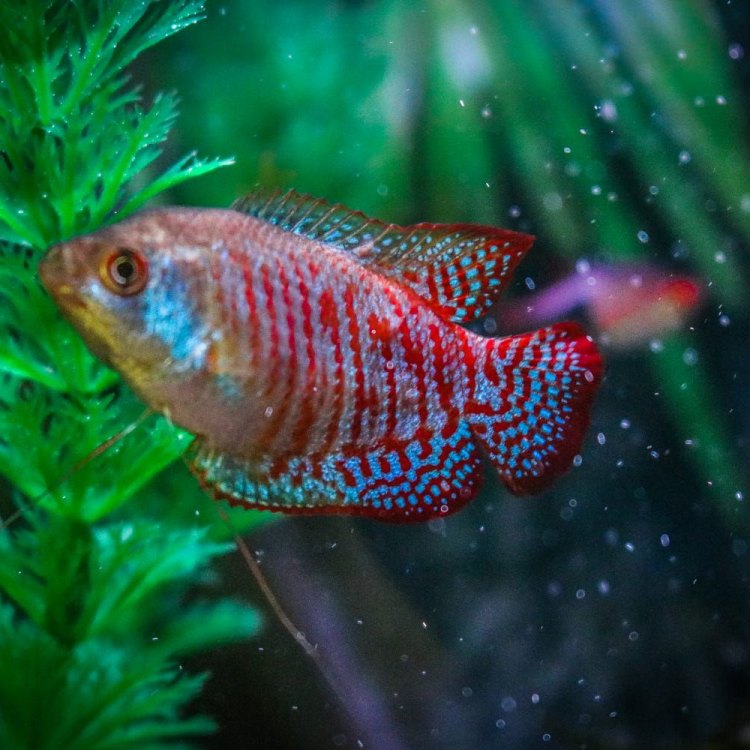
Dwarf Gourami
- Adult Size: 2-4 centimeters (0.8-1.6 inches)
- Average Lifespan: 3-4 years
- Reproduction: Sexual
- Reproductive Behavior: Male builds a bubble nest to attract the female for spawning
- Sound or Call: No specific sound or call
- Migration Pattern: Non-migratory
- Social Groups: Solitary or in small groups
- Behavior: Peaceful and relatively docile
- Threats: Habitat loss and water pollution
- Conservation Status: Not listed as endangered
- Impact on Ecosystem: Important for maintaining aquatic ecosystems
- Human Use: Popular aquarium fish
- Distinctive Features: Females are paler in color compared to males
- Interesting Facts: The males are known for their territorial behavior and vibrant colors
- Predator: Predatory fish, birds, and larger aquatic animals
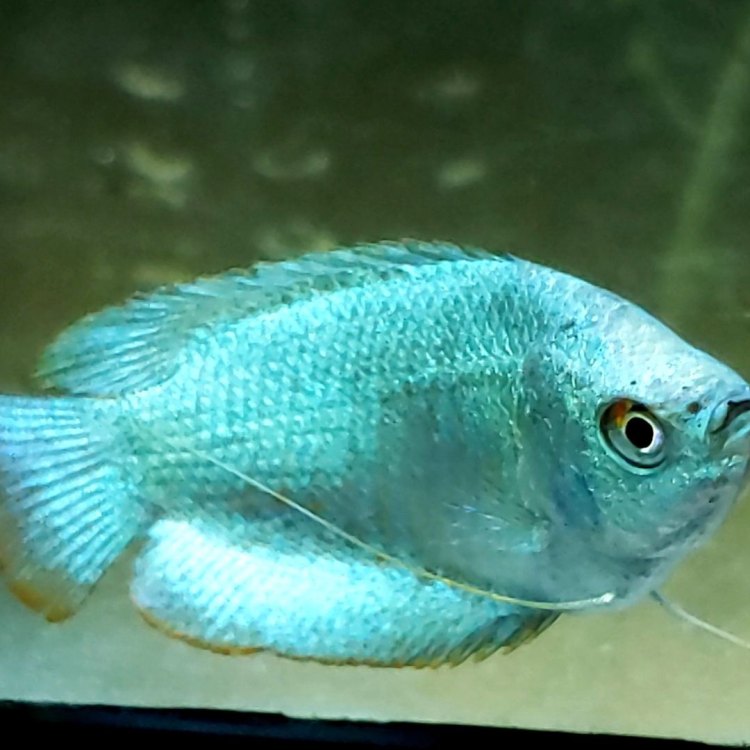
Trichogaster lalius
The Colorful World of Dwarf Gourami Fish: An Important Aquatic Species
In the vast and diverse world of aquatic life, there is a family of colorful little fish known as the Dwarf Gourami. These small but fascinating creatures have captured the hearts of many aquarium hobbyists with their vibrant colors, interesting behaviors, and peaceful nature. But beyond their popularity as aquarium pets, Dwarf Gourami fish also play a crucial role in maintaining the delicate balance of aquatic ecosystems. In this article, we will explore the unique features and importance of the Dwarf Gourami in the world of marine life PeaceOfAnimals.Com.The Basics: Physical Features, Size, and Behavior
The Dwarf Gourami (scientific name: Trichogaster lalius) is a species of freshwater fish belonging to the Gourami family. They are native to the slow-moving freshwater streams and rivers of South Asia, specifically India, Pakistan, and Bangladesh. Their body length ranges from 2-4 centimeters (0.8-1.6 inches) when fully grown, making them one of the smallest species of Gourami. However, their size does not diminish their beauty, as they come in a variety of striking colors such as red, blue, and orange.Unlike other fish species, Dwarf Gouramis have a unique organ known as the "labyrinth organ," which allows them to breathe air directly from the surface of the water. This is an evolutionary adaptation that enables them to survive in poorly oxygenated water and make them a great choice for beginner aquarium keepers. Although they prefer still or slow-moving waters, they are also capable of surviving in moderately strong currents Desert Locust.
The Lifecycle of a Dwarf Gourami
On average, Dwarf Gouramis can live up to 3-4 years, but with proper care and a suitable habitat, they can sometimes exceed this timeframe. Reproducing sexually, males and females have distinctive features and behaviors during the breeding season. The male Gourami takes on a bright and vibrant hue to attract the female for spawning, while the female remains relatively duller in color. The male also builds a bubble nest at the water's surface to entice the female into laying her eggs. After the female releases her eggs, the male fertilizes them and then subsequently guards and maintains the nest to ensure the survival of the fry (baby fish).The Peaceful Nature of Dwarf Gouramis
One of the most interesting features of Dwarf Gouramis is their peaceful and docile nature. In the wild, they are known to live alone or in small groups, making them non-aggressive towards their own species. This behavior translates well to their life in aquariums, as they can coexist with other peaceful fish and invertebrates without any issues. However, care must be taken when choosing tank mates, as small and aggressive fish may pose a threat to these delicate creatures.Threats and Conservation Status
Dwarf Gouramis, like many other species of aquatic life, face various threats in their natural habitat. One of the significant challenges that they face is habitat loss due to human activities such as agriculture, deforestation, and development. This loss of natural habitat can disrupt their breeding patterns and significantly reduce their population. Furthermore, water pollution also poses a severe threat to Dwarf Gouramis, as they are highly sensitive to changes in water quality.Despite these threats, Dwarf Gouramis are not listed as endangered. However, it is essential to note that they are not as prevalent in the wild as they once were. Therefore, it is crucial to protect their natural habitats and ensure that their numbers do not continue to decline.
The Importance of Dwarf Gouramis in Ecosystems
As with every species of aquatic life, Dwarf Gouramis also have a vital role to play in maintaining the balance of their ecosystems. As omnivorous fish, they feed on a variety of food sources such as small insects, algae, and tiny crustaceans. By consuming these organisms, they regulate their populations and prevent any one species from dominating the ecosystem. In turn, this helps promote biodiversity and ensures the survival of other aquatic species.Additionally, Dwarf Gouramis also serve as a food source for predatory fish, birds, and larger aquatic animals. Without these small fish, the food chain in aquatic ecosystems would be disrupted, causing significant problems for the entire ecosystem.
The Dwarf Gourami in Human Culture
The Dwarf Gourami's colorful appearance and peaceful nature have made it a popular choice for aquarium hobbyists worldwide. In fact, they are one of the top-selling aquarium fish globally, second only to the famous Guppy. In many South Asian cultures, they are also regarded as a symbol of prosperity and are often gifted to newlyweds as part of wedding traditions.Furthermore, Dwarf Gouramis have also been a subject of traditional medicine in some regions. Some believe that their labyrinth organ contains healing properties that can alleviate respiratory issues and improve overall health. However, it is essential to note that this belief has no scientific evidence backing it and that these fish should never be used for medicinal purposes.
Interesting Facts about Dwarf Gouramis
Aside from their notable behaviors and unique features, there are many interesting facts about Dwarf Gouramis that make them stand out. For instance, did you know that male Gouramis are known for their territorial behavior? As part of their reproductive behavior, males mark their territory by creating bubble nests and become fiercely protective of their nests. This territorial behavior extends to their life in aquariums, where they may chase away any fish that gets too close to their designated area.Another interesting fact is that the colors of male Dwarf Gouramis can change depending on their mood and surroundings. When they are happy, they exhibit their brightest hues, while they tend to become dull and pale when stressed or unwell. By paying close attention to their colors, aquarium keepers can easily determine the well-being of these fish and take necessary steps to ensure their health and happiness.
The Ultimate Predator: Threats to Dwarf Gouramis
While Dwarf Gouramis are relatively peaceful creatures, they are not immune to predation. In the wild, they are preyed upon by larger fish, birds, and other aquatic animals. Young Dwarf Gouramis are especially vulnerable to predators due to their small size and lack of protective mechanisms. In aquariums, they may also face threats from larger and aggressive fish that may see them as potential food sources. Therefore, it is crucial to create a suitable habitat for these fish and ensure they have proper hiding places to evade potential predators.In Conclusion
In summary, Dwarf Gouramis may be small in size, but they are undoubtedly significant in the world of aquatic life. Their peaceful nature, vibrant colors, and important role in maintaining ecosystems make them unique and valuable creatures. However, their population is declining due to various threats, making it more crucial than ever to protect their natural habitats and ensure their survival. So, the next time you see these colorful little fish swimming in an aquarium, remember their significance and the role they play in the delicate balance of our aquatic world.
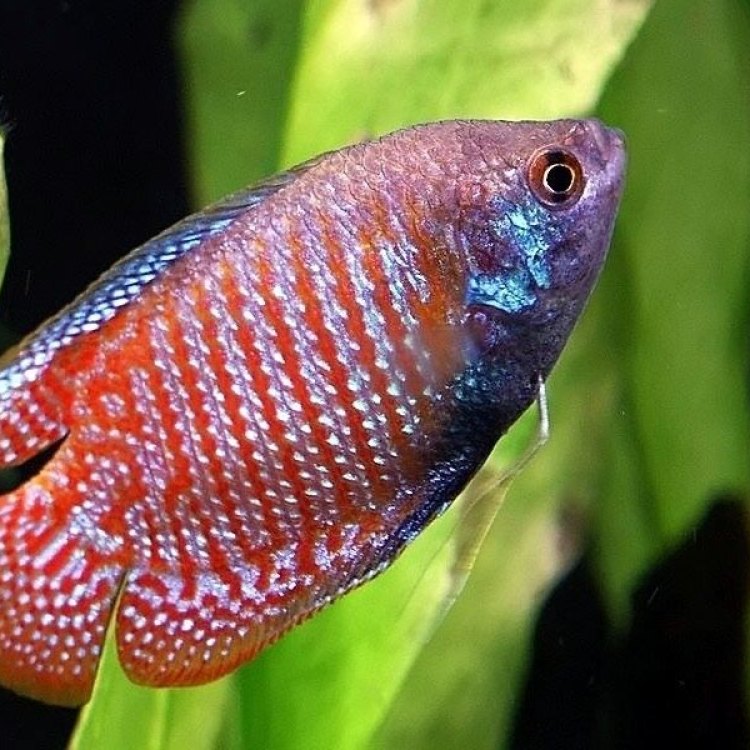
The Fascinating World of Dwarf Gouramis
Disclaimer: The content provided is for informational purposes only. We cannot guarantee the accuracy of the information on this page 100%. All information provided here may change without prior notice.

